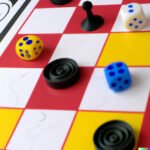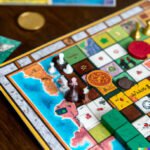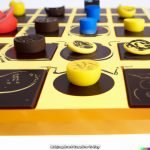Mahjong, a classic board game originating from China, has been capturing the hearts and minds of players for centuries. With its intricate tiles, strategic gameplay, and rich cultural symbolism, Mahjong Classic Board Game continues to entertain and challenge individuals around the world. But what exactly is Mahjong? How did it come to be? In this introductory section, we will explore the origins of Mahjong and provide an overview of this beloved game.
Mahjong Classic Board Game can trace its roots back to ancient China, where it was believed to have been created during the Qing Dynasty in the mid-19th century. The game was initially played by a select few in noble circles but soon gained popularity among the general population. Over time, it spread across East Asia and eventually made its way to different parts of the world through trade routes and migration.
The objective of Mahjong Classic Board Game is to construct specific sets by drawing tiles from a wall made up of numerous tiles with various symbols. Each player takes turns drawing and discarding tiles until they complete a winning hand.
However, achieving victory requires more than just luck – it demands careful strategy, calculation, and an understanding of the symbols represented on the tiles. As we delve deeper into this article, we will explore the rules and gameplay mechanics that make Mahjong such a compelling pastime.
So join us as we embark on an exploration of Mahjong Classic Board Game – its fascinating history, engaging gameplay, vibrant symbolism, variations across different cultures, tips for mastering the game, influence on popular culture, cognitive and social benefits, platforms where you can play online or in local clubs – ultimately preserving its legacy as one of the most cherished board games ever created.
The Rules and Gameplay of Mahjong Classic Board Game
Mahjong is a classic board game that originated in China and has become increasingly popular worldwide. The game is played with a set of tiles and involves strategy, skill, and a bit of luck. In this section, we will delve into the rules and gameplay of Mahjong Classic Board Game.
- Objective: The main objective in Mahjong is to be the first player to complete a winning hand by collecting sets of tiles according to specific patterns. A winning hand consists of four sets (either sets or runs) and one pair.
- Tiles: The Mahjong Classic Board Game includes a total of 136 tiles, which are divided into different categories such as suits, honors, winds, and dragons. Each category has its own distinctive symbols and meanings.
- Dealing the Tiles: At the beginning of the game, all tiles are shuffled face down on the table and then built into a wall. The dealer rolls dice to determine where to break the wall and begin dealing tiles to each player.
- Turn Sequence: Players take turns drawing one tile from either the end of the wall or from the dead wall (the row of discarded tiles). They can then choose to discard a tile from their hand or declare specific combinations if they have them.
- Declaring Combos: If a player has a valid combination of tiles in their hand, they can declare it by exposing it on the table for other players to see. This can include sets (three identical tiles) or runs (three consecutive numbers within the same suit).
- Winning Hand: To win the game, players must complete their hand by collecting four sets (either sets or runs) and one pair that satisfies specific patterns known as “hands” or “fan.” There are numerous possible fan combinations that result in different scores for each winning hand.
- Scoring: At the end of each round, players calculate their score based on various factors such as the value of the winning hand, the dealer status, and any special combinations achieved. The player with the highest score at the end of a predetermined number of rounds is declared the winner.
Being familiar with these rules will provide a solid foundation for playing Mahjong Classic Board Game. However, it’s important to note that there are different variations and regional adaptations of Mahjong, each with their own unique rules and gameplay mechanics. In the next section, we will explore these variations and how they differ from the classic version.
Understanding the Tiles and Symbolism in Mahjong Classic Board Game
In Mahjong Classic Board Game, the tiles used in gameplay are an essential component of the game. Each tile has its own symbolism and significance, adding depth and meaning to the overall experience. Understanding these tiles and their symbolism is crucial for players looking to master the game and fully immerse themselves in its rich cultural heritage.
There are three main types of tiles in Mahjong: suit tiles, honor tiles, and bonus tiles. Suit tiles are divided into three categories: bamboo (or bams), characters (or craks), and dots (or dots). Each category consists of nine numbered tiles from one to nine. These suit tiles represent different aspects of life, such as nature, seasons, and elements.
Honor tiles depict various symbols that hold cultural significance in Chinese traditions. These include four winds (north, south, east, west), three dragons (red dragon or center dragon, green dragon or left dragon, white dragon or right dragon), and four flowers. The honor tiles represent different virtues and qualities associated with each symbol.
Lastly, bonus tiles are unique to Mahjong Classic Board Game variations. These can include additional special tiles like jokers or wild cards that can be used as substitutes for any other tile.
Understanding the symbolism behind these tiles not only enhances the aesthetic appeal of Mahjong but also provides players with valuable insights into Chinese culture and traditions. It allows players to connect with the profound meanings associated with each tile as they navigate through the game.
To help players familiarize themselves with the different symbols on the Mahjong tiles, below is a list summarizing each category:
– Suit Tiles:
- Bamboo/Bams: Represents nature, growth, and flexibility.
- Characters/Craks: Represents individuals, emotions, and relationships.
- Dots/Dots: Represents wealth, prosperity, abundance.
– Honor Tiles:
- Winds: Represent direction and change.
- North Wind: Symbolizes knowledge and wisdom.
- South Wind: Represents warmth and compassion.
- East Wind: Signifies strength and growth.
- West Wind: Symbolizes harmony and balance.
- Dragons: Symbolize power and protection.
- Red Dragon/Center Dragon: Represents virtue and righteousness.
- Green Dragon/Left Dragon: Represents kindness and peace.
- White Dragon/Right Dragon: Signifies purity and clarity.
- Flowers: Represent beauty, joy, and renewal.
By understanding the symbolism of the tiles, players can deepen their appreciation for the game’s cultural significance while also enhancing their gameplay strategies. The diverse array of symbols within Mahjong Classic Board Game tiles adds an element of depth to each round, making every move a meaningful experience.
Exploring the Different Variations and Regional Adaptations of Mahjong
Mahjong is a classic board game that has evolved over centuries, resulting in various regional adaptations and gameplay variations. While the fundamental rules remain consistent, the tile designs, scoring systems, and special combinations can differ significantly across different regions. Exploring these different variations adds depth and excitement to the game, allowing players to experience new challenges and strategies.
One popular variation is Cantonese Mahjong, which is widely played in Hong Kong and other southern regions of China. In this version, there are three suits: dots, bamboos, and characters. It also includes honor tiles such as winds (north, south, east, west) and dragons (red dragon, green dragon, white dragon). Cantonese Mahjong emphasizes strategic play and complex scoring methods. The game incorporates additional features like bonus tiles, where certain sets grant extra points.
Another variant is Japanese Mahjong (also known as Riichi Mahjong), which gained significant popularity in Japan after World War II. This version differs from traditional Chinese Mahjong in several ways. It places more emphasis on defensive play rather than offensive strategies by allowing players to declare “riichi,” meaning they are one tile away from winning. Additionally, Japanese Mahjong introduces a unique scoring system called yakus (specific patterns), which determines the value of each completed hand.
In American Mahjong, players utilize a unique set of tiles that includes jokers for added flexibility in forming sets. This version incorporates elements of both Chinese and Western gameplay styles while introducing its own distinct rules and hands. American Mahjong is known for its social appeal, often played at gatherings or events.
Exploring these different variations of Mahjong allows players to appreciate the cultural diversity surrounding this classic board game. Each region has added its own flair to the game’s mechanics and design elements while still honoring its core principles. Whether you prefer the strategic complexity of Cantonese Mahjong or the defensive tactics of Japanese Mahjong, there is a variant out there that will suit your preferences and keep you engaged for hours of gameplay.
| Mahjong Variation | Distinct Features |
|---|---|
| Cantonese Mahjong | – Three suits: dots, bamboos, and characters
|
| Japanese Mahjong (Riichi Mahjong) | – Emphasis on defensive play– “Riichi” declaration for being one tile away from winning
|
| American Mahjong | – Utilizes a unique set of tiles with jokers
|
Tips and Strategies to Master Mahjong Classic Board Game
Understanding the Basics
Before diving into the specific tips and strategies, it’s important to have a solid understanding of the basics of Mahjong Classic Board Game. Mahjong is typically played with four players and a set of 144 tiles, although there are variations that can be played with three players or even by oneself. The objective of the game is to create sets of tiles that match certain combinations, such as sequences or triplets.
One key aspect of Mahjong is the concept of turns and rounds. Each player takes turns drawing tiles from the wall until they have a winning hand or all the tiles have been drawn. The game is played over several rounds, with each round consisting of multiple hands. Points are awarded based on who wins each hand and how they win it.
Focus on Building a Balanced Hand
One essential strategy in Mahjong Classic Board Game is to focus on building a balanced hand. A balanced hand consists of a good mixture of numbered tiles from different suits, along with honor tiles like winds and dragons. By having multiple options for creating sets, you increase your chances of winning.
It’s also important to pay attention to which tiles your opponents are discarding. This can give you clues about what sets they are working on or what suits they may be avoiding. For example, if an opponent frequently discards certain numbers or suits, it may be advantageous for you to hold onto those tiles for potential scoring opportunities.
Avoid Unnecessary Risks
While taking risks can sometimes pay off in Mahjong Classic Board Game, it’s usually best to avoid unnecessary risks that may result in penalties or losing points. One common mistake beginners make is holding onto overly specific tile combinations too early in the game. Instead, it’s often better to focus on building a more general hand that allows for more flexibility and potential scoring opportunities.
Additionally, it’s important to be mindful of the timing and strategy of declaring Mahjong. Declaring Mahjong too early in the game may result in your opponents being able to adjust their strategies and catch up, while declaring it too late may result in missed scoring opportunities. Finding the right balance and timing for declaring Mahjong requires practice and observation of your opponents’ gameplay.
By understanding the basics, focusing on building a balanced hand, and avoiding unnecessary risks, you’ll be well on your way to mastering Mahjong Classic Board Game. Remember that experience is key, so keep practicing and honing your skills to become a skilled player in this timeless game.
Mahjong Classic Board Game in Pop Culture
Mahjong has made its way into popular culture and has been featured in various movies, TV shows, and video games. The inclusion of Mahjong in these mediums reflects its widespread appeal and enduring popularity. Whether depicted as a simple social game or used as a dramatic plot device, Mahjong has become an iconic symbol in entertainment.
Movies
Mahjong has been prominently featured in several films throughout the years. One notable example is the 1990 film “The Joy Luck Club,” directed by Wayne Wang. This critically acclaimed movie explores the lives of four Chinese-American women and their complicated relationships with their mothers. Mahjong serves as a metaphor for these complex connections, as the characters use the game to bridge generational gaps and convey their emotions.
Another film that showcases Mahjong is “Crazy Rich Asians” released in 2018. In this romantic comedy, adapted from Kevin Kwan’s novel, Mahjong represents traditional Chinese values and serves as a backdrop for crucial scenes involving family dynamics and power struggles. The inclusion of Mahjong in these films not only adds cultural authenticity but also adds depth to the storytelling.
TV Shows
In addition to movies, Mahjong has also appeared in various TV shows across different genres. For instance, the award-winning series “Mad Men” features a memorable scene where protagonist Don Draper plays Mahjong with his wife’s friends. The game becomes an allegory for dominance and control within relationships.
Mahjong has even made its mark on reality television with shows like “The Big Bang Theory.” In one episode, the characters engage in a high-stakes match of strip Mahjong while showcasing its competitive nature and strategic gameplay.
Video Games
Lastly, Mahjong has found its way into the world of video games. Numerous digital adaptations of the game are available for players to enjoy on various platforms. These video games range from traditional Mahjong setups to creative variations that incorporate elements of puzzle-solving and strategy.
One popular example is “Mahjong Titans,” a standard version of the game included in older versions of Microsoft Windows. It offers a relaxing gameplay experience with different tile designs and layouts to choose from. Other video games, such as “Mahjong Solitaire” and “Ultimate Mahjongg 20,” provide unique challenges and themed environments for players to explore.
Overall, the portrayal of Mahjong in movies, TV shows, and video games not only highlights its widespread popularity but also contributes to its cultural significance beyond just being a traditional board game. By incorporating Mahjong into these forms of media, it reaches new audiences and showcases its rich history and gameplay to a global audience.
The Benefits of Playing Mahjong Classic Board Game
Playing Mahjong Classic Board Game not only provides hours of entertainment, but it also offers several cognitive and social benefits. This section will discuss the various advantages that come with playing Mahjong Classic Board Game, highlighting its positive impact on mental stimulation and social interactions.
One of the key cognitive benefits of playing Mahjong Classic Board Game is that it helps improve memory and concentration skills. The game requires players to memorize the different types of tiles and their corresponding patterns, as well as strategize and plan their moves. This constant mental exercise can enhance memory retention and sharpen focus over time.
Additionally, playing Mahjong Classic Board Game can stimulate critical thinking and problem-solving abilities. With multiple combinations and strategies available, players must carefully analyze the board and make calculated decisions. This promotes logical reasoning skills and encourages players to think strategically, ultimately improving their problem-solving capabilities.
Moreover, Mahjong Classic Board Game is known for its social aspects, making it an excellent way to foster connections with others. Whether played with family members or friends, the game allows for meaningful interactions and bonding opportunities. The friendly competition involved in Mahjong Classic Board Game can create a sense of camaraderie among players as they engage in lighthearted banter and laughter throughout the game.
| Cognitive Benefits | Social Benefits |
|---|---|
| Improves memory and concentration skills | Fosters connections with others |
| Stimulates critical thinking | Provides bonding opportunities |
| Enhances problem-solving abilities | Promotes camaraderie through friendly competition |
Where to Play Mahjong Classic Board Game
Mahjong Classic Board Game has gained immense popularity over the years, making it readily available for enthusiasts to play both online and in local clubs. For those who prefer the convenience of playing from home or on the go, there are numerous online platforms dedicated to providing a virtual Mahjong experience.
Online platforms offer a variety of options for players to choose from. Some websites provide a solo gaming experience where players can practice their skills against computer opponents. Others offer multiplayer modes that allow users to compete against friends or join global tournaments. These platforms often include features such as chat rooms and leaderboards, enhancing the social aspect of the game.
On the other hand, local clubs provide an opportunity for players to gather and enjoy a more traditional Mahjong experience. Joining a club allows individuals to engage with fellow enthusiasts in person, fostering a sense of community and camaraderie. Clubs often organize regular meetups or tournaments where players can test their skills and learn from one another. Additionally, being part of a club opens up avenues for networking and forming lasting friendships within the Mahjong community.
Whether opting for online platforms or local clubs, it is essential to choose reputable sources that prioritize fair play and user safety. Researching reviews and recommendations from other players can help ensure you select reliable platforms or find reputable clubs in your area. Ultimately, deciding where to play Mahjong Classic Board Game depends on personal preference – some may value the convenience and accessibility of online platforms while others may appreciate the authenticity and social interaction provided by local clubs.
Preserving the Legacy of Mahjong Classic Board Game
The game of Mahjong has a rich and interesting history that spans over a century. It originated in China during the late Qing Dynasty and quickly gained popularity among the upper class as a social activity. As time went on, it also became popular among people from all walks of life, becoming an integral part of Chinese culture. Today, Mahjong is not only played in China but has also spread to different parts of the world.
The historical significance of Mahjong lies in its ability to connect people across generations and cultures. The game has managed to transcend borders and has become a beloved pastime in many countries. Its origins in ancient China make it an important cultural artifact, showcasing the traditions and values of the time. By preserving and passing down the game through generations, we are able to keep this aspect of history alive.
Furthermore, Mahjong is more than just a game; it serves as a reflection of society. The rules and gameplay are influenced by societal norms and customs, making it an interesting study for sociologists and historians alike. The tiles themselves are adorned with various symbols and characters that hold deep meaning within Chinese culture. By studying these symbols, we gain insight into the beliefs and values cherished by our ancestors.
Preserving the legacy of Mahjong involves not only teaching others how to play the game but also sharing its historical background. From hosting local tournaments to creating dedicated spaces for players to gather and share their experiences, efforts can be made to promote awareness about the cultural significance of Mahjong. Organizing exhibitions or lectures on Mahjong’s history can help educate both players and non-players about its importance.
Conclusion
In conclusion, Mahjong Classic Board Game is a timeless and captivating game that has captured the hearts of players worldwide for many generations. Its origins in ancient China add an air of mystery and tradition to the game, making it not only entertaining but also culturally significant.
Throughout this article, we have explored the various aspects of Mahjong Classic Board Game – from its rules and gameplay to the symbolism behind the tiles, as well as its different variations and adaptations in different regions.
One of the key takeaways from this exploration of Mahjong Classic Board Game is the importance of strategy and critical thinking in achieving success. As players navigate through the game, they must carefully plan their moves and consider the potential outcomes. This aspect of the game not only makes it intellectually stimulating but also improves cognitive abilities such as problem-solving, memory retention, and strategic thinking.
Furthermore, Mahjong Classic Board Game serves as a bridge between cultures and generations. Its presence in pop culture through movies, TV shows, and video games has introduced countless individuals to this traditional game, promoting cultural exchange and understanding. Whether it be playing with friends online or joining local clubs in person, there are numerous platforms available for enthusiasts to enjoy Mahjong Classic Board Game.

I love playing all kinds of games – from classics like Monopoly to modern favourites like Ticket to Ride.
I created this blog as a way to share my love of board games with others, and provide information on the latest releases and news in the industry.





